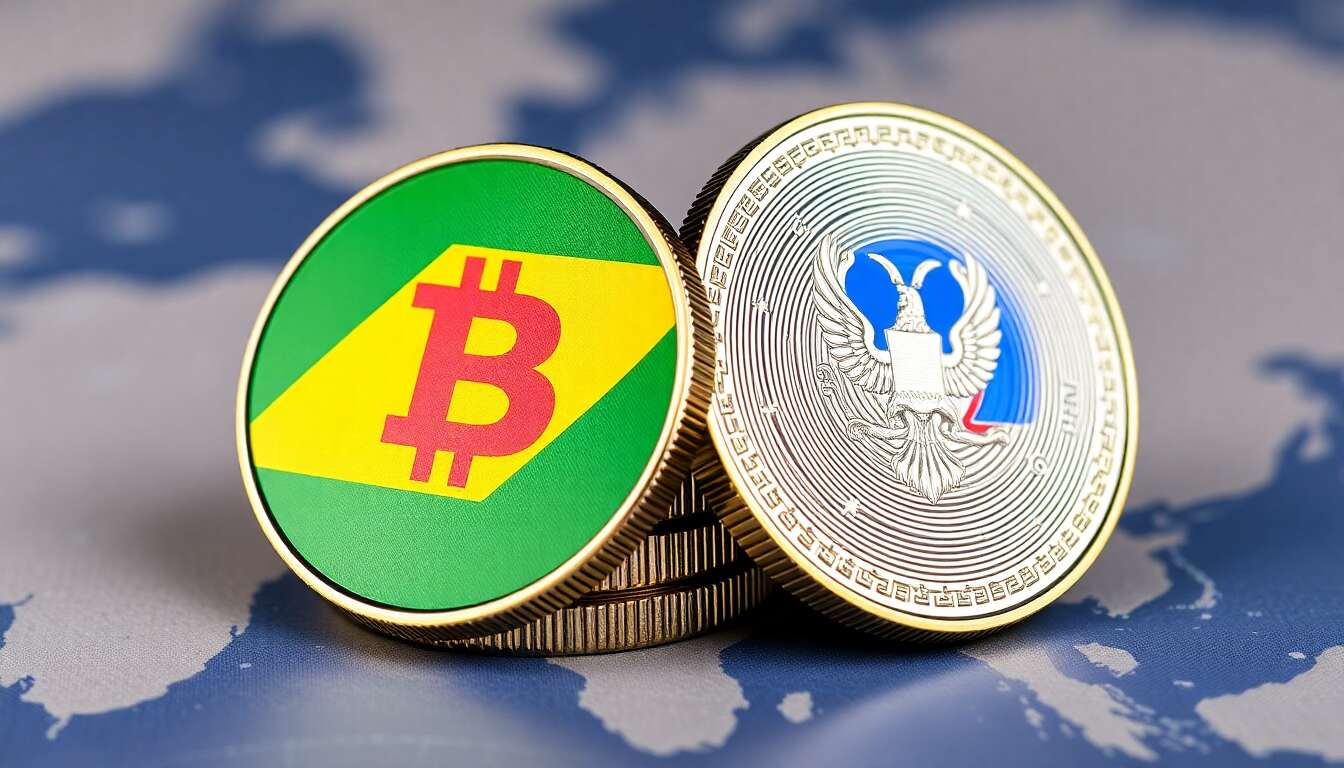Amidst evolving global economic dynamics, the concept of digital currencies is gaining significant traction. Countries like Brazil and Russia are spearheading this transformation with their respective digital real and digital ruble initiatives. These efforts by member nations of the BRICS (Brazil, Russia, India, China, South Africa) are poised to pave the way for a potential unified digital currency, commonly referred to as the BRICS Coin. As these nations strive for financial autonomy and resilience, the implications on the global monetary landscape could be substantial.
Le réal numérique et le rouble numérique : vers une révolution monétaire ?

The Vision Behind Digital Real and Digital Ruble
The introduction of the digital real in Brazil and the digital ruble in Russia marks a significant shift towards monetary innovation among BRICS nations. The Brazilian digital real aims to enhance financial inclusion and streamline transactions, while the Russian digital ruble seeks to circumvent traditional international payment systems that currently dominate global financial transactions. Both countries are driven by a common goal: to establish more control over their financial systems and detach from the overwhelming influence of the US dollar.
Security and Efficiency in Digital Transactions
A critical aspect of these digital currencies is the enhanced security and efficiency they promise to bring. For instance, the Central Bank of Russia’s digital ruble pilot project, launched in 2020, aims to facilitate secure and cost-effective international payments. This initiative is particularly pivotal for Russia as it navigates through the economic sanctions imposed by the West. The digital ruble is designed to provide an alternative to traditional systems such as SWIFT from which Russia has been excluded.
Economic Impacts and Challenges
While the shift towards digital currencies is promising, it does come with its set of challenges. Transitioning to a digital currency framework requires developing robust technological infrastructure and regulatory frameworks. These innovations also need widespread adoption among citizens and businesses for maximum effectiveness. Nonetheless, the potential to revolutionize monetary systems is profound, from lowering transaction costs to facilitating cross-border payments.
As Brazil and Russia move forward with their digital currency initiatives, a broader discussion unfolds about the potential impacts on the global economy.
Les monnaies numériques du BRICS : un tournant pour l’économie mondiale

BRICS Nations Leading the Digital Currency Charge
Collectively, the BRICS countries represent a significant portion of the world’s population and economic output. The introduction of national digital currencies in these nations could mark a turning point for global economic practices. These digital currencies could provide BRICS nations with an enhanced ability to engage in commerce that bypasses existing financial hurdles associated with dollar-dominated transactions.
Strategic Autonomy from the US Dollar
One of the main motivations for the BRICS to explore digital currencies is the desire to achieve monetary autonomy. By reducing reliance on the US dollar, these nations aspire to shield their economies from geopolitical tensions and sanctions. The digital ruble and real are seen as tools to bolster financial independence, proving invaluable for conducting international trade without falling prey to external economic pressures.
Potential Economic Benefits
The strategic deployment of digital currencies among BRICS nations could yield several economic benefits:
- Reduced transaction costs, making trade more economical.
- Increased financial inclusion, fostering economic growth.
- Decreased dependency on foreign currencies, enhancing economic stability.
Embracing digital currencies could optimize the economic synergy within the BRICS, setting the stage for a more integrated global financial system.
Système de paiement blockchain : vers une intégration transfrontalière
Blockchain as the Backbone of Financial Integration
The adoption of blockchain technology is central to integrating these digital currencies across borders. Blockchain provides a secure, decentralized platform that can facilitate cross-border payments, advancing the integration efforts among the BRICS nations. By leveraging blockchain’s capabilities, these countries aim to achieve seamless and transparent transactions, devoid of intermediary banks.
Advantages of a Blockchain-Based System
Blockchain offers numerous advantages that align with the objectives of the digital currency initiatives:
- Transparency: All transactions are visible and traceable, reducing fraud.
- Security: Encryption ensures the safety of financial data and user identities.
- Efficiency: Speeds up transaction times and reduces processing costs.
Implementing Cross-Border Systems
Implementing a common blockchain-based payment system among BRICS countries necessitates collaboration and interoperability. By establishing a decentralized payment system, these nations could facilitate international trade and investment, enhancing their economic resilience. This concerted effort marks a significant step towards a cohesive financial identity for the BRICS coalition, showcasing their commitment to digital progression.
The establishment of a unified blockchain system sets the foundational infrastructure necessary for the potential launch of a BRICS Coin, aimed at redefining global transactional norms.
La BRICS Coin : une nouvelle ère pour les transactions globalisées

Concept and Objectives of the BRICS Coin
The potential introduction of a BRICS Coin represents an innovative leap towards global financial harmony. Conceived as a unified digital currency, the BRICS Coin seeks to facilitate trade and investment among member nations while minimizing reliance on existing global financial systems dominated by the dollar. Such an initiative could significantly influence global financial order, positioning BRICS at the helm of the digital currency revolution.
Benefits and Challenges of Implementing a BRICS Coin
The creation of a BRICS Coin could offer numerous benefits:
- Enhanced Trade Opportunities: A common currency streamlines transactions among member nations.
- Strengthened Economic Ties: Facilitates economic cooperation and cohesion.
- Increased Financial Sovereignty: Reduces susceptibility to foreign exchange rate fluctuations.
However, challenges such as regulatory disparities, currency stabilization, and integration logistics must be addressed. The successful implementation of a BRICS Coin would require a harmonized approach to legal, technological, and economic policies.
Redesigned Global Financial Architecture
The potential arrival of the BRICS Coin signifies a paradigm shift in global financial operations. With an infrastructure already being laid through individual digital currencies and blockchain-based payment systems, the BRICS Coin could be the final piece in a comprehensive international monetary strategy. This evolution in the global financial landscape reflects the weight and direction of economic power towards emerging markets and away from traditional financial hubs.
The trajectory of digital currency development within the BRICS coalition underscores the complex interplay between economic innovation and geopolitical strategy. The emergence of a unified currency could usher in a new era, challenging the existing world economic order.
As the financial world watches closely, the digital ruble and real offer the first glimpse into a future where national and regional economic entities wield potentially transformative power over the existing global financial architecture, revealing the dynamic nature of future fiscal landscapes.



